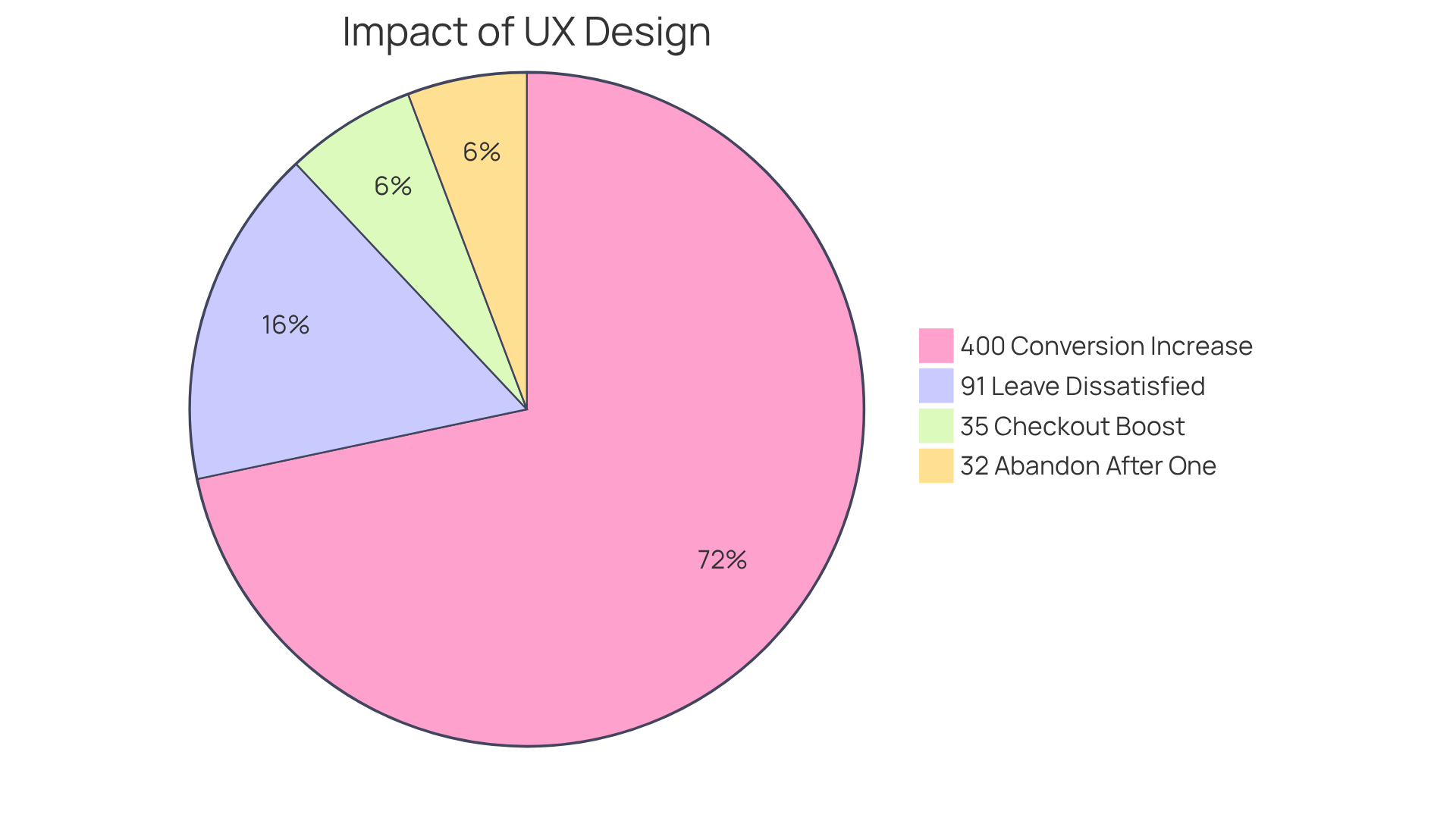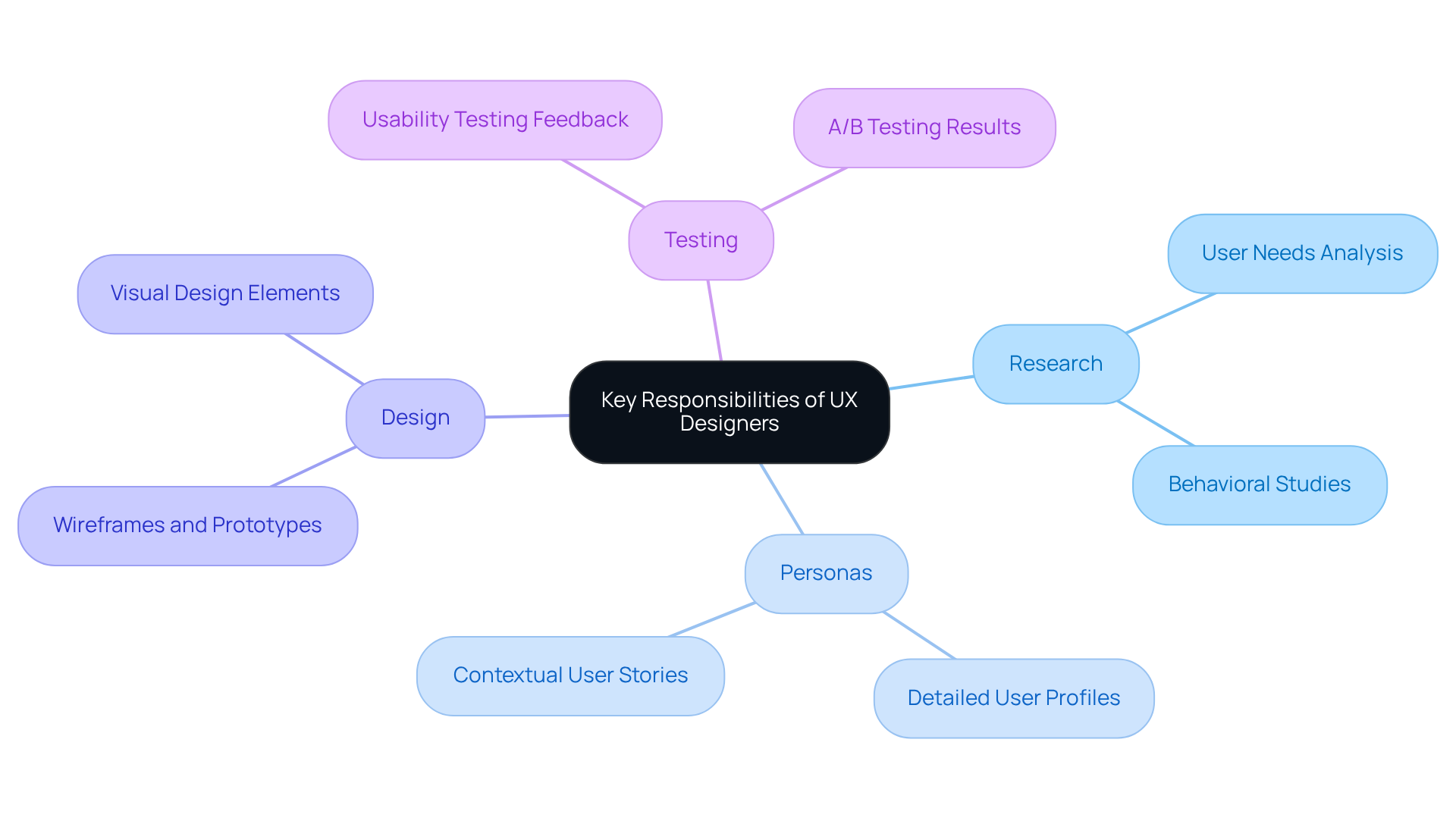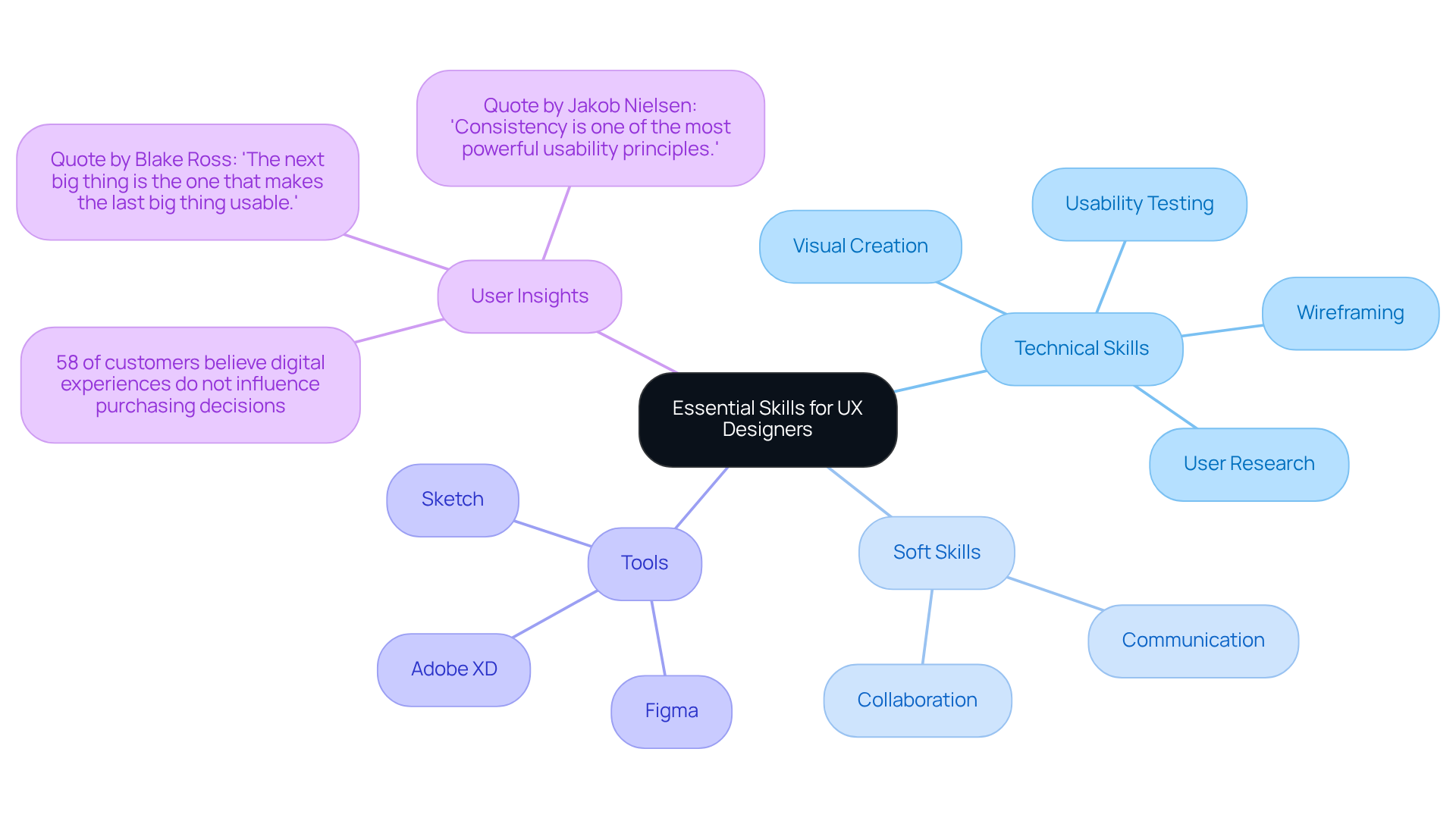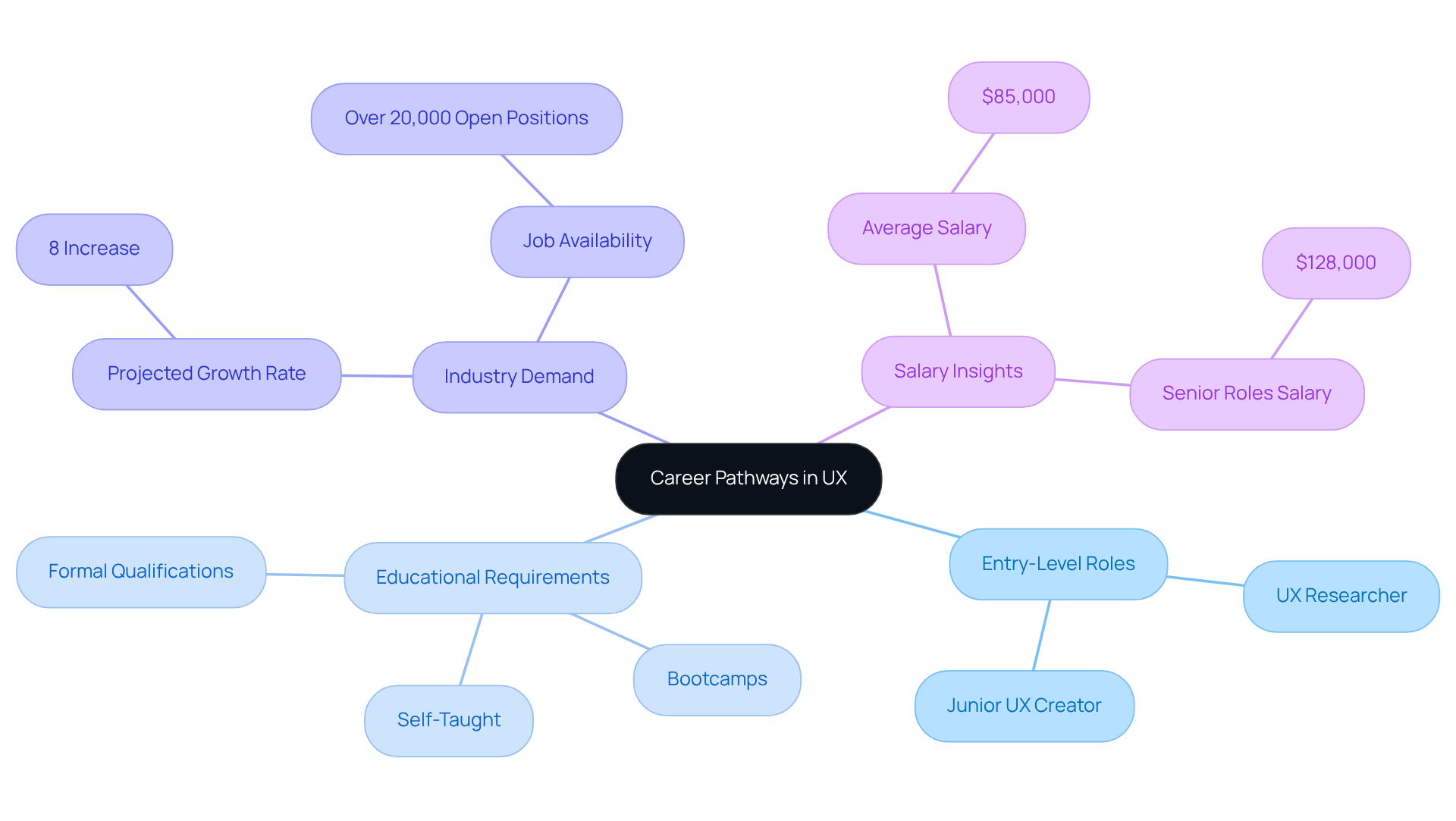Overview
In today's digital landscape, user experience designer jobs have become increasingly vital. Many tech startup founders face the challenge of enhancing customer satisfaction and engagement, which can feel overwhelming. It’s essential to recognize that successful UX design not only improves user interactions but also significantly impacts business outcomes.
Statistics reveal that:
- Every dollar invested in UX can yield a return of up to $100.
- This highlights the importance of thoughtful design strategies in fostering brand loyalty and driving conversion rates.
By prioritizing user experience, startups can create a nurturing environment that supports their growth and connects them with their audience. Investing in UX is more than just a business decision; it’s a commitment to understanding and valuing the needs of your customers, ultimately leading to a more successful and sustainable venture.
Introduction
In a world where digital interactions shape customer relationships, the challenges faced by user experience (UX) designers are more pressing than ever. Many businesses find themselves struggling to create experiences that are not only satisfying but also engaging. This struggle can lead to a disconnect with customers, making it crucial to understand the nuances of UX design. It’s essential for fostering brand loyalty and driving growth.
Yet, as the landscape continually shifts, one might wonder: what does it truly take to thrive in this field? By exploring the responsibilities, skills, and career pathways of UX designers, we can uncover not just the demands of the profession but also the immense potential for those willing to navigate its complexities. Together, we can embrace this journey and discover how to succeed in creating meaningful experiences.
Define User Experience Design and Its Importance
In today’s fast-paced digital landscape, many businesses struggle with ensuring their customers feel satisfied and valued. This challenge often stems from usability issues, accessibility barriers, and a lack of enjoyment during product interactions. At RNO1, we understand these pain points deeply. Our commitment lies in creating that not only enhance but also foster digital growth for modern businesses. By prioritizing , we help and engagement, allowing brands to shine in a competitive market.
Research shows that can elevate by as much as 400%. This statistic serves as a powerful reminder of the potential to drive sales and enhance customer retention. For example, a study found that simply optimizing checkout processes could result in a 35% increase in conversion rates, translating to significant recoverable losses from cart abandonment. It’s sobering to note that 91% of dissatisfied clients choose not to voice their concerns but instead quietly leave, underscoring the to retain customers. Furthermore, 32% of clients might abandon a beloved brand after just one negative experience, illustrating the vital importance of maintaining positive engagements.
Expert insights echo this sentiment, revealing that every dollar invested in UX can yield an astounding return of $100, which amounts to a remarkable 9,900% ROI. This compelling financial incentive reinforces the necessity for brands to prioritize UX development as a foundational aspect of their strategy. Successful case studies, such as our partnership with RentMethod, which played a pivotal role in their acquisition by Airbnb through improved interactions, demonstrate that not only enhances satisfaction but also nurtures . This makes it an indispensable element for brands eager to thrive in competitive markets.
We invite you to reflect on your own . Have you noticed how a smooth interaction can transform your relationship with a brand? At RNO1, we are here to support you in overcoming these challenges, ensuring that your brand not only meets but exceeds the expectations of your customers.

Outline Key Responsibilities of UX Designers
In today's competitive landscape, many tech startups struggle to create a meaningful experience, highlighting the demand for . This challenge can lead to frustration, as founders often find themselves navigating the complexities of user expectations and business goals. The implications are significant: without a strong user experience (UX), engagement and satisfaction can dwindle, which can affect user experience designer jobs and leave both clients and businesses feeling unfulfilled.
At RNO1, we understand the weight of this issue. Our to through a diverse range of responsibilities. They:
- Conduct thorough research to uncover the needs and behaviors of users.
- Create detailed personas.
- Design intuitive wireframes and prototypes.
- Perform usability testing to gather invaluable feedback.
This collaborative process is vital; our user experience designer jobs involve and developers to ensure that the final product not only meets client expectations but also aligns with overarching business objectives.
Consider the partnerships we've forged, such as our . Together, we redefined digital branding and customer interaction, showcasing how strategic UX can drive scalable brand growth. It's remarkable to note that designer jobs can yield a return of up to $100, underscoring the .
Moreover, successful initiatives in user experience designer jobs, like those we've executed for , have demonstrated the potential to . This illustrates how thoughtful design can significantly impact user interactions. Yet, it's essential to recognize that 32% of customers would abandon a beloved brand after just one negative experience, emphasizing the critical importance of maintaining a positive consumer journey.
By focusing on the customer's journey, user experience designer jobs profoundly influence how individuals engage with products, ultimately fostering loyalty and satisfaction. We invite you to share your experiences and challenges with us; together, we can create a nurturing environment that not only addresses your needs but also for your users.

Identify Essential Skills for UX Designers
In the ever-evolving landscape of , a significant challenge arises: many users feel that their interactions with digital platforms fall short of their expectations. This disconnect can lead to frustration and lost opportunities for businesses. As UX professionals, we face the responsibility of bridging this gap through :
- User research and analysis
- Wireframing and prototyping
- Visual creation
- Usability testing
Yet, it's not just about technical skills; are vital, as we often find ourselves working within cross-functional teams.
Imagine a team collaborating seamlessly, armed with tools such as Sketch, Figma, and Adobe XD, crafting user-friendly visuals that resonate with users. These tools empower us to effectively communicate our concepts and collaborate with developers and stakeholders. However, as our field progresses, expertise in data analysis and familiarity with AI-driven creation tools are becoming increasingly important. These skills enable us to design tailored and impactful interactions, responding to the growing demand for smooth digital engagement.
A recent study by Gartner revealed a startling truth: 58% of customers believe that most digital experiences do not influence their purchasing decisions. This highlights the in shaping user perceptions and experiences. Expert insights emphasize that nurturing communication not only enhances team dynamics but also significantly contributes to the success of our projects. As Blake Ross wisely stated, 'The next big thing is the one that makes the last big thing usable.' This underscores our in our creations.
Furthermore, consider this: research indicates that 45% of people would be less inclined to make a purchase if they faced unexpected delays. This reinforces the essential role of usability in retaining customers and fostering loyalty. Incorporating Jakob Nielsen's insight that 'consistency is one of the most powerful usability principles' further strengthens our argument about the necessity of and collaboration in . Together, we can create meaningful interactions that not only meet user needs but also nurture lasting relationships with them.

Explore Career Pathways and Educational Requirements
Navigating career pathways in can feel overwhelming, especially as many professionals transition from diverse fields like graphic arts, psychology, or computer science. This journey often brings uncertainty, and while a formal qualification in UX or a related field can provide a solid foundation, it’s important to recognize that many successful individuals are self-taught or have honed their skills through . Entry-level roles, such as , are stepping stones that pave the way toward senior positions or specialization in areas like interaction development or UX strategy.
As the continues to rise—projected to increase by 8% according to the US Bureau of Labor Statistics—it’s crucial to stay informed about industry trends and engage in . This dedication not only enhances career progression but also fosters personal growth in this dynamic field. Industry leaders consistently highlight that exceptional emerges from a profound understanding of user needs, underscoring the significance of ongoing education and adaptability in achieving success in UX.
Moreover, the stands at around $85,000, with senior roles reaching as high as $128,000. Currently, there are over 20,000 designer jobs available in the UX field, showcasing the strong demand for dedicated professionals. Embracing this journey with a mindset of learning and adaptability can lead to fulfilling opportunities and a rewarding career in UX.

Conclusion
User experience design is not just a technical necessity; it is a vital component that shapes how customers engage with digital products. When businesses overlook the importance of crafting seamless and enjoyable user experiences, they risk losing customer satisfaction and loyalty. As the demand for skilled UX designers rises, it becomes increasingly clear that investing in this area is essential for long-term success.
Many organizations may not realize the staggering return on investment associated with thoughtful UX design. Improved conversion rates can be achieved through intentional user interactions, making it imperative for businesses to prioritize this aspect. UX designers take on significant responsibilities, including:
- Research
- Prototyping
- Usability testing
All aimed at enhancing user satisfaction. It’s important to acknowledge that successful collaboration within teams hinges on both technical expertise and strong communication skills.
In a world where user expectations are constantly evolving, it’s clear that investing in user experience design is not merely a trend; it is a necessity for businesses looking to thrive. By prioritizing UX, organizations can foster deeper connections with their customers, leading to increased loyalty and lasting success. For aspiring UX professionals, the pathways available are promising, and embracing continuous learning and adaptability will be crucial in making a meaningful impact in this dynamic industry.
Let us remember that the journey towards exceptional user experiences is a shared one. As we navigate this landscape together, let’s commit to nurturing our skills and supporting one another in our endeavors. Together, we can create a future where user experience design is at the forefront of every successful business strategy.
Frequently Asked Questions
What is user experience (UX) design?
User experience (UX) design focuses on creating design solutions that enhance user interactions with digital products, ensuring customers feel satisfied and valued.
Why is UX design important for businesses?
UX design is crucial as it helps cultivate brand loyalty and engagement, drives sales, and enhances customer retention. It addresses usability issues and accessibility barriers that can hinder customer satisfaction.
How can effective UX design impact eCommerce conversion rates?
Effective UX design can elevate eCommerce conversion rates by as much as 400%. For instance, optimizing checkout processes could lead to a 35% increase in conversion rates, significantly reducing cart abandonment losses.
What are the consequences of poor user experience?
Poor user experience can lead to high customer dissatisfaction, with 91% of dissatisfied clients choosing not to voice their concerns and leaving quietly. Additionally, 32% of clients may abandon a brand after just one negative experience.
What is the financial return on investing in UX design?
Research indicates that every dollar invested in UX can yield a return of $100, equating to a remarkable 9,900% ROI, highlighting the financial benefits of prioritizing UX development.
Can you provide an example of successful UX design implementation?
A successful example is RNO1’s partnership with RentMethod, which improved user interactions and played a pivotal role in their acquisition by Airbnb, demonstrating the long-term loyalty that effective UX design can foster.
How does RNO1 support businesses in improving their UX?
RNO1 offers design-focused solutions to help businesses overcome UX challenges, ensuring that their brands meet and exceed customer expectations through enhanced user interactions.




